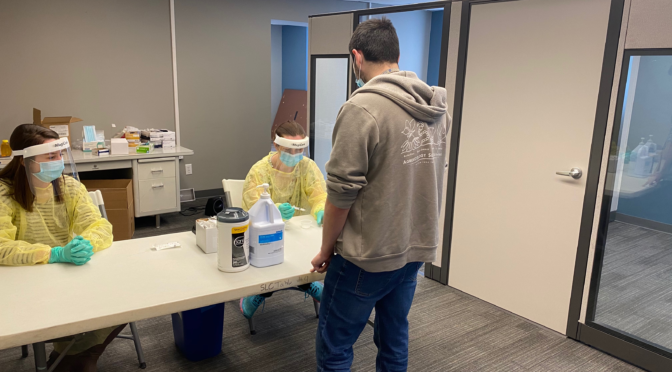Each month, a faculty member, nominated by their dean, is recognized for their efforts to integrate innovative technology into their classroom. November’s digital faculty member of the month is Jill Allen, assistant professor of psychology & neuroscience, College of Arts & Sciences. Read an interview with Jill:
What course do you use this technology in? Psychology 030: Social Psychology
What type of technology do you use? In-Class real-time polls, built into the University Zoom platform.
In what context do you use this technology? The polls operate as a type of formative assessment; they are graded based on completion and contribute to an overall amount of “participation” in the online course. These polls punctuate the lecture, by giving students active participation in constructing their knowledge, and then sharing their rationale with the class, via their mics.
How does this type of technology align with your teaching pedagogy? I need students in this course to be active consumers of the social psychological concepts, and as such, these questions serve as a check point to prepare them for exams.
Where did you get the inspiration to make a change? I have been a polling enthusiast from my first introduction, thanks to colleagues Olga Lazareva in Psychology and Karly Good in ITS and dear friend and former colleague, Jaime Grandstaff in Accounting. My favorite polling software is PollEverywhere, and in the online context it is in Zoom. I enjoy the “real time” engagement – a step above and beyond the “looks of aha moments” on students’ faces (or conversely, sticking points of clarification/confusion), which are often missing in online classes, without all students having cameras turned on.
How long did it take for you to implement this technology? I began to use the polls in 2017, and became a “regular” on the helpline with the regional reps for Turning Point Technologies and our own Learning Management team on campus. After a few weeks, I would have considered myself a novice user and by the end of one semester, I felt confident in leveraging the technology. However, I have switched platforms several times, and each time, it is a new opportunity to learn/grow/compare/contrast with previous software. Importantly, and most interestingly, the goal never changes – but the medium and device does!
Since transitioning to remote teaching, how has your use of this technology changed, if at all? I was presented with an interesting dilemma regarding my go-to polling software, PollEverywhere. It has an online component, and it would have been possible to continue using it for Zoom synchronous lectures (students pay a modest yearly fee). On the other hand, teaching and learning online is a lot of change, so I opted to use the free/integrated features in Zoom. I like facilitating the discussions from within the same platform, and I think this creates more consistency and equity in experience for students who may be joining across many different types of devices.
Since transitioning to remote teaching, have you started using any new technology in your teaching? Interestingly, I had an experience last semester (pre-COVID) in which I noticed my students in this course were “in a rut.” Despite I love the polls and all they can offer; the class environment lacked the kind of energy and excitement as the start of the term provided. So, I walked into class, and presented a slide that said, “In a Rut? Let’s get unstuck…” in which I told students they would be working on a problem-based activity of cognitive dissonance on a shared Google doc (each group would have a different problem, but once complete they could review the class responses), that they would be numbered off so they worked with different folks than their usual table seating arrangements, and that the class collective responses would be the basis for a few new exam questions I would create. And you know what, IT WORKED! This type of collaborative activity is one I have adopted into Zoom breakouts, so that students can engage with peers in a structured way and I’m happy to have experimented with it in a F2F class setting.
Overall, what lessons do you think you have learned while transitioning to remote teaching? I think the biggest take-away from mid-March to now in a fully virtual setting for my classes, has been to create social connection. What I cannot control is how students engage with each other, but I can create a welcoming, warm, and humanizing environment in the way would have tried to create if we were in person. For instance, I use my camera for all synchronous lectures, try to share humorous anecdotes from my own life of teaching remotely and the oddities of COVID-life, and share reminders to seek balance and self-care, despite a pandemic that have been helpful for me and may be helpful for students, as well.
Did Drake ITS assist you in implementing any of these technologies? I would be remiss to not share gratitude for the tireless support of Karly Good in ITS. She has answered my early morning and late-night emails, phone calls, formal ticket requests, and connected me with colleagues on campus with similar teaching goals/pedagogies. This summer I took advantage of the Center for Teaching Excellence consultation opportunities, and gained excellent insight from Bill Klein, in Drake Online & Continuing Education, about making the “leap” between Blackboard Collaborate and Zoom. I also received generous support from the A&S Dean’s Office to fund a better remote-teaching setup, as well – all of which, helped me to bring the best “online” version of myself to the classroom that is possible.
Are you interested in trying out new technology in your classroom? Want help from ITS? Schedule a technology adoption consultation.
Want to learn more about using Blackboard Collaborate, PollEverywhere or Zoom in your course? Explore these knowledge base guides/categories:
Blackboard Collaborate:
https://drake.teamdynamix.com/TDClient/2025/Portal/KB/ArticleDet?ID=45313&SIDs=5893
PollEverywhere: https://drake.teamdynamix.com/TDClient/2025/Portal/KB/ArticleDet?ID=63097&SIDs=2012
Zoom:
https://drake.teamdynamix.com/TDClient/2025/Portal/KB/?CategoryID=18578&SIDs=7847
— Jon Hurdelbrink, CPHS, and Carla Herling, ITS

